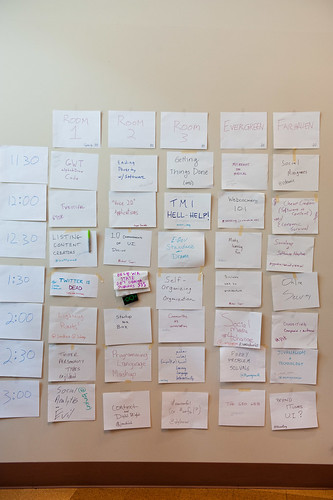Last night I finally made it over to one of the Ignite Seattle events. I’d been wanting to get over for one of them, but part of the rub is getting a ride from the ferry to the actual location. Fortunately, Ryan Stewart was kind enough to give me a lift to and fro.
Ignite has a very interesting format. There’s a MAKE event before the talks get underway. The talk section is grouped into 30 minutes of talks and 30 minutes of mixing, which is repeated for either 2 or 3 talk blocks total. The talks themselves are 5 minutes long and you get 20 slides and 15 seconds per slide — the slides advance automatically, so it really is 15 seconds. If you’re a listener, it means you get a bunch of talks in a short time, and you are guaranteed that you only have to endure a bad or uninteresting talk for 5 minutes. If you are a speaker, it means that you really need to have your act together. It’s a challenging format, and even some experience speakers have trouble making it work for them.
Highlights of the talks:
Karen Anderson‘s Work Place Survival Tips – there was one really good one — I hope she blogs it. I had a camera in my hand, so my attention was divided.
Scott Berkun did what might best be described as a brief history of the decline of Attention.
Shelly Farnham of Waggle Labs talked about social tagging, which is the idea of tagging people with semantics which might be useful. She used the example of tagging people at conferences with tags that would help them connect with each other. That’s a problem that resonates with me, but you can easily imagine other domains where this idea would be helpful. Best of show. I’m looking forward to seeing what Pathable.com turns out to be.
Christopher Johnson‘s talk on names was particular interesting, because we’ve been doing some branding stuff at OSAF, and I found his approach based on sounds interesting. Even more interesting was his analysis of how Apple’s name related to the attriubutes of the Apple brand.
Mark Novak from Microsoft crammed a security analysis of OpenID into 5 minutes by talking really fast. The 5 minute format means that the talks are also a kind of performance art. If you were an expert and familiar with his notation it was possible to follow the talk. If not, the performance was really good.
Eric Nevala of the US Marine Corp talked about his experiences running IT for the Marines in Iraq. Eric received sustained applause and support from the audience.
The Twitter backchannel for Ignite was projected on a wall. It was fun to watch some of that chatter go by, and you can use it to get a feel for what happened. After the whole thing was over, Ryan and I spent some time talking to Monica Guzman of the Seattle PI about the merits (or not) of Twitter.
On the whole I had a great time. I got to see some friends I hadn’t seen in a while, and the talks and format were good. I like seeing folks tinkering with meeting formats — I hope that there’ll be more of that in general. Between Mind Camp and Ignite, the technology community in Seattle might be bumping it up a notch. Kudos to Brady and Bre!
I did have a camera with me, and the pictures are up on this Flickr set.



